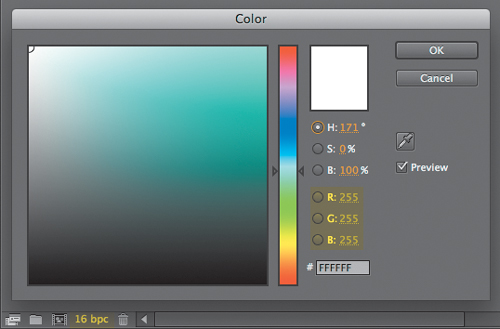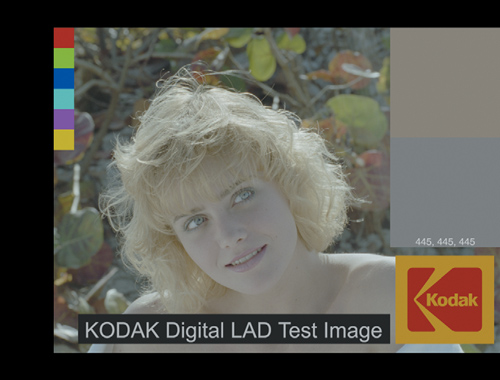It may still be the case that the majority
of After Effects artists spend the majority of time working in 8 bits
per channel, also known as monitor color. This section details the many
ways in which you can do better. The simplest and least costly of these
is to move from 8-bpc to 16-bpc mode.
Notes
All but the oldest and most
outdated effects and plug-ins support 16-bpc color. To discern which
ones do, with the project set to 16 bpc, choose Show 16 bpc-Capable
Effects Only from the Effects & Presets panel menu. Effects that
are only 8 bpc aren’t off-limits, but it may be helpful to place them
at the beginning (or end) of the image pipeline, where they are least
likely to cause quantization by mixing with higher-bit-depth effects. |
1. 16-Bit-Per-Channel Composites
After Effects 5.0 added support for 16-bpc color for one basic reason: to eliminate color quantization,
most commonly seen as banding, where subtle gradients and other
threshold regions appear in an image. 16-bpc mode adds 128 extra
gradations between each R, G, B, and A value of the familiar 8-bpc mode.
Those increments are typically too fine for your eye to distinguish (or your monitor to display), but the eye easily notices
banding, and multiple adjustments to 8-bpc images will cause banding to
appear in areas of subtle shading, such as edge thresholds and shadows,
making the image look bad. To raise project color depth, either Alt-click (Opt-click) the color depth setting at the bottom of the Project panel or use the Depth menu in File > Project Settings.
There are really only a couple of downsides to
working in 16 bpc instead of 8. There is a performance hit from the
increased memory and processing bandwidth, but on contemporary systems
it is typically negligible.
Tip
The Info panel menu color value settings determine color values everywhere in the application, including the Adobe Color Picker. |
The real resistance tends to come from the
unfamiliarity of 16-bit color values, but switching to 16-bpc mode
doesn’t mean you’re stuck with incomprehensible pixel values such as
32768, 0, 0 for pure red or 16384, 16384, 16384 for middle gray. The
panel menu of the Info panel allows you to choose whichever numerical
color representation works for you, including familiar 8-bpc values
when working in 16 bpc (Figure 1). The following sections use the 8-bpc values of your monitor despite referring to 16-bpc projects.

Even if your output is 8 bpc, the higher precision
of 16 bpc will eliminate quantization and banding. However, there is
more to color flexibility than toggling 16 bpc in order to avoid
banding. You may even have source images with values beyond standard
8-bit color.
2. Film and Cineon Files
Although
film as a recording medium is on the wane, the standards and formats of
film remain common in the pipelines of studios working on digital
“films” for the big screen. 10-bit Cineon .dpx files remain a common
format for storing feature film images. The process of working with
film can teach plenty about how to handle higher dynamic ranges in
general, and even newer formats can output film-style .dpx sequences,
so here’s a brief description of the process.
After 35mm or 16mm film has been shot, the negative
is developed, and shots destined for digital effects work are scanned
frame by frame. During this Telecine
process, some initial color decisions are made before the frames are
output as a numbered sequence of Cineon files, named after Kodak’s
now-defunct film compositing system. Both Cineon files and the related
format, DPX, store pixels uncompressed at 10 bits per channel. Scanners
are usually capable of scanning 4K plates, and these have become more
popular for visual effects usage, although many still elect to scan at
half resolution, creating 2K frames around 2048 by 1536 pixels and
weighing in at almost 13 MB.
The world’s most famous Cineon file is Kodak’s original test image, affectionately referred to as Marcie (Figure 2) and available from Kodak’s web site (www.kodak.com/US/en/motion/-support/dlad/) . To get a feel for working with film, drop the file
called dlad_2048X1556.cin from the 11_output_simulation folder into
After Effects, which imports Cineon files just fine.

The first thing you’ll notice about Marcie is that
she looks funny, and not just because this photo dates back to the
’80s. Cineon files are encoded using a logarithmic (log) tone response
curve. To make Marcie look more natural, open the Interpret Footage
dialog, select the Color Management tab, click Cineon Settings, and
choose the Over Range preset (instead of the default Full Range). Aah,
that looks better; the log image is now converted to the monitor’s
color space.
It
would seem natural to convert Cineon files to the monitor’s color
space, work normally, and then convert the end result back to log, but
to do so would be to throw away valuable data. Try this: Apply the
Cineon Converter effect and switch the Conversion Type from Linear to
Log. This is a preview of how the file would be written on output back
to a Cineon log file. Upon further examination of this conversion, you
see a problem: In an 8-bpc (or even 16-bpc) project, the bright details
in Marcie’s hair don’t survive the trip (Figure 3).

What’s going on with this mystical Cineon
file and its log color space that makes it so hard to deal with? And
more importantly, why? Well, it turns out that the engineers at Kodak
know a thing or two about film and have made no decisions lightly. But
to properly answer the question, it’s necessary to discuss some basic
principles of photography and light.